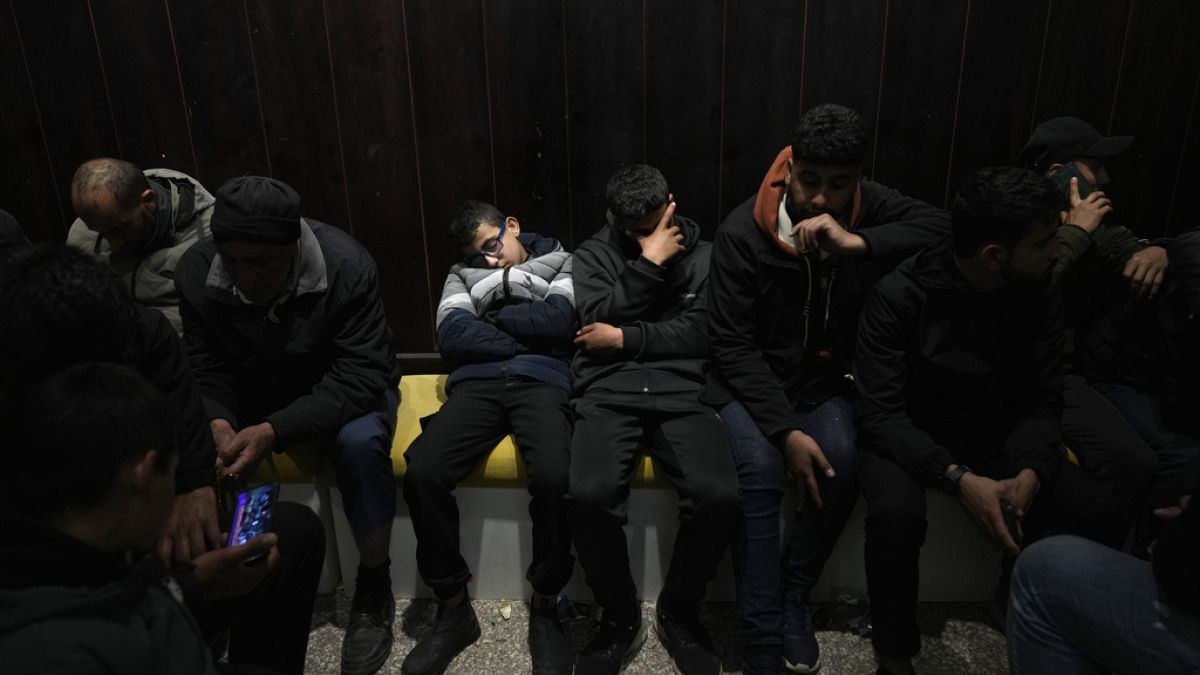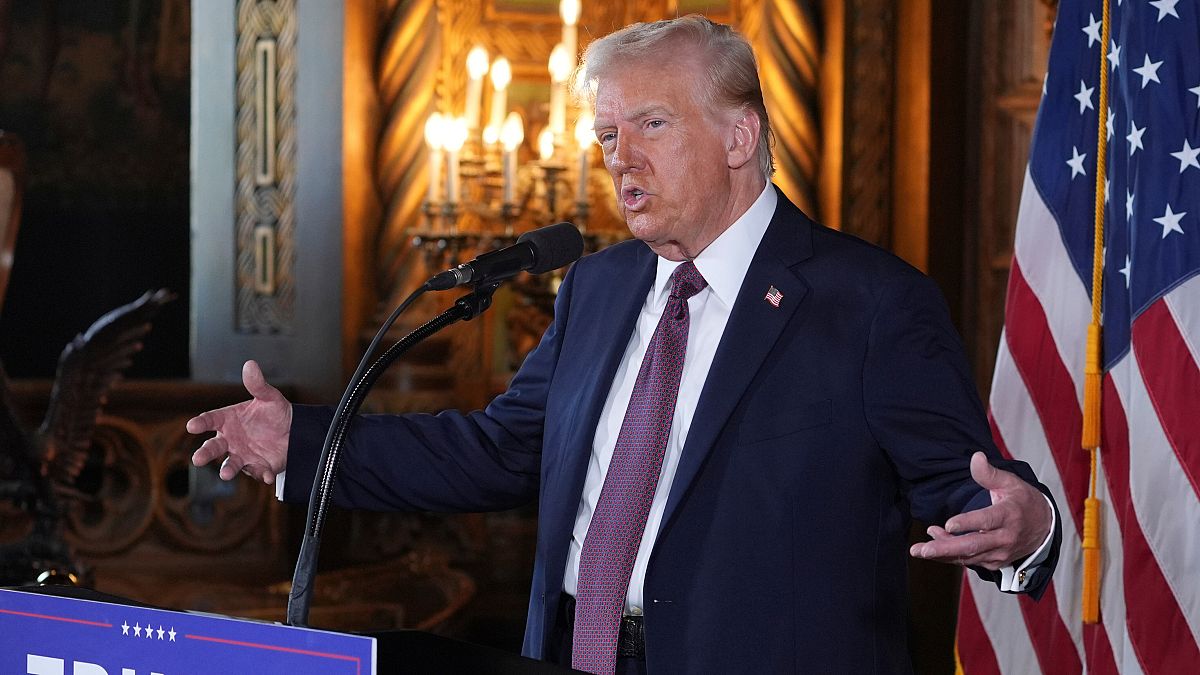How the Trump-Vance platform could win or lose
Donald Trump never stops talking about immigration, trade and the economy. Those policy areas have animated all three of the former president’s campaigns for the White House, and he often finds ways to morph other topics into border security, tariffs, taxes and inflation when he’s riffing on the campaign trail. And for years — amid […]

Donald Trump never stops talking about immigration, trade and the economy.
Those policy areas have animated all three of the former president’s campaigns for the White House, and he often finds ways to morph other topics into border security, tariffs, taxes and inflation when he’s riffing on the campaign trail. And for years — amid an influx of migrants and the rising price of everyday goods — Trump has had fodder to throw at the Biden administration.
Trump has at times leaned further into his positions on these issues during his latest campaign — not just promising to seal the border with Mexico, but now saying he will conduct the largest deportation in American history.
And while Trump’s pick for vice president, Sen. JD Vance (R-Ohio), had repeatedly said he didn’t like Trump before joining the ticket, he is now, in some ways, a complement to Trump: a young populist conservative from humbler beginnings, far from the coastal elite. Vance also echoes a lot of Trump’s foreign policy views and immigration restrictions.
Here’s a crash course on where the Trump-Vance ticket stands on key issues, how their positions may play with voters and whether they are becoming the target of Democratic attacks.
Abortion
Donald Trump: “As most people know, and for those who would like to know, I am strongly Pro-Life, with the three exceptions — Rape, Incest and protecting the Life of the mother — the same position taken by Ronald Reagan.”
JD Vance: “The question to me really is about the baby. We want women to have opportunities, we want women to have choices, but above all, we want women and young boys in the womb to have the right to life.”
Trump has long said he believes abortion restrictions should be decided by the states while noting that he supports exceptions for rape and incest. But after he followed through on his promise to appoint Supreme Court justices who would help overturn Roe v. Wade, a position that won him support among religious conservatives, the issue has gotten only more complicated for him.
The GOP saw backlash in the midterms among a key group of voters — white women with college degrees — linked to the fall of Roe. Trump has been working to not risk losing that bloc in November while also keeping his base happy, many of whom are clamoring for more restrictions.
The Trump campaign has, at times, avoided the issue and doesn’t list it in his Agenda 47.
Trump hasn’t said whether he would use executive power to curb patient access to the procedure, such as barring delivery of abortion pills by mail. And he’s largely dodged questions about vetoing a national abortion ban, saying Congress would never pass such a measure and put him in the position to make that decision.
Like nearly all modern vice presidential nominees, Vance has aligned his views with the top of the ticket on the campaign trail. But the Ohio senator has said he’s as “pro life as anyone” and once supported a nationwide ban.
On in vitro fertilization, Trump has become a vocal supporter. He has not only said he supports access to IVF nationwide, but touted himself as a “leader” on the fertility treatment — pledging free IVF for all Americans, whether paid for by health insurance plans or the federal government.
But Democrats see Trump’s positions on reproductive health helping them in November, making abortion and IVF among their most consistent attack lines, from ads to forcing votes in the Senate.
Democrats have also hailed Harris as a more powerful messenger on abortion than Biden, who often struggled to say the word.
Immigration
Trump: “As soon as I take the oath of office, we will begin the largest deportation operation in the history of our country.”
Vance: “What happens when you have massive amounts of illegal immigration? It actually starts to create ethnic conflict. It creates higher crime rates.”
Immigration is one of the cornerstone issues of Trump’s candidacy and appeal, dating back to when he first announced his original run for president in 2015. His promises to seal the border and carry out “the largest deportation in American history” top the priorities on his Agenda 47.
He’s promising to both slash the levels of immigration and reduce the number of undocumented immigrants overall, saying he would “send them all back to their countries where they belong.”
Trump’s first administration — which emphasized building a wall along the southern border, restricting immigration from several Muslim-majority countries and making generalizations between immigrants and crime — may also offer clues to his policies in a potential second term.
His administration tried to end DACA, a program to protect undocumented immigrants who entered the U.S. as children. He pushed “zero tolerance” policies that separated children from their parents at the border in a bid to deter migrants from coming to the U.S. Yet, more recently, he has supported giving green cards to foreign-born graduates of American universities.
Trump will often pivot to immigration when asked about other policy issues, saying his deportation program would solve shortfalls in Medicaid funding, for example, though undocumented immigrants are not covered by most states’ Medicaid programs. He said the “migrant invasion” is causing “immense inflationary pressure” across the economy.
Vance has also taken a hard-line approach to immigration policy. He has continued to push rumors that immigrants are stealing and eating their neighbors’ pets in his state, despite no verifiable evidence to support the claims.
He also has a record of mounting new government efforts to push out people who entered the country illegally, supporting legislation that would pull federal aid from schools that hire undocumented immigrants.
Some voters may respond to Trump’s tougher approach. Americans have shifted significantly on immigration in recent years, according to Gallup, with the majority of people — no matter their party affiliation — wanting the level of immigration reduced. But there isn’t a clear consensus on all of Trump’s policies: some polling suggests his push to end DACA and use of child separation policies were unpopular.
Some Democrats have used Trump’s claims — and his administration’s earlier practices, such as separating children from their parents at the border — to appeal to swing voters. Harris has called his proposals extreme, suggesting detention camps and massive raids would be needed to carry out his plan. But Harris is also promising to be tough on illegal border crossings and distancing herself from the Biden administration’s record on the issue.
Inflation, tariffs and the economy
Trump: “If you don’t make your product here, then you will have to pay a tariff, a very substantial tariff, when you send your product into the United States.”
Vance: “I certainly think we should be much more aggressive in applying tariffs on a whole host of industries.”
Trump has highlighted inflation as a key reason for voters to put him back in the White House, saying he would lower prices on everyday goods, boost the economy and increase U.S.-based manufacturing.
His Agenda 47 includes pledges to “end inflation” and turn the country into “a manufacturing superpower.”
Cutting federal spending and regulations, as well as increasing energy production and reducing immigration, are key elements of Trump’s plan to tackle inflation and spur economic growth.
He has vowed to enact a 20 percent tariff on most imports — and even more for goods coming from China.
But there are concerns that some of those tariffs would ultimately raise prices for consumers and hinder economic growth. Some economists are suggesting they could cause a recession. A tariff on oil imports, for instance, could mean hikes in gas prices, market analysts say.
Trump has wrongly asserted that tariffs would be paid largely by foreign governments, not U.S. consumers and businesses.
Vance is mostly in line with Trump on increasing tariffs, especially on goods coming from China, saying they’re needed to protect American industry. He’s said such policies would protect American workers who have seen their jobs outsourced — a claim that may resonate with voters in key swing states, such as Pennsylvania.
Democrats have worked to highlight the burden voters might bear should Trump get the chance to enact his proposals. Harris has said Trump’s plan would only increase everyday costs for Americans.
But the Biden administration’s hike in tariffs on Chinese electric vehicles, for instance, and its decision to keep tariffs established during Trump’s first term, have made it difficult to broadly criticize the tactic.
Voters are highly motivated by economic issues, and Republicans have looked to pin the increases in the cost of living on Biden and Harris. But voters remain split both on Trump’s specific trade policies and which candidate would ultimately be better for the country’s economic outlook. Harris appears to be gaining ground among professional-class voters while Trump appears to be making progress with the working-class electorate.
Energy and the environment
Trump: “We will drill, baby, drill.”
Vance: “Even if there was a climate crisis, I don’t know how the way to solve it is to buy more Chinese-manufactured electric vehicles.”
Trump has pledged to make America the dominant global energy producer and scrap government action to stop climate change.
He said he would again withdraw the U.S. from the Paris Climate Agreement and do away with EV mandates, a continuation of the work directed under his first term rolling back more than 100 climate-focused rules. Some environmental policy experts believe Trump will be more effective in rolling back policies at the Environmental Protection Agency.
Unspent funds from the Inflation Reduction Act, the largest pot of money directed at addressing climate change in U.S. history, would be clawed back under a Trump plan.
The former president has been a strong ally of the fossil fuel industry, promising to allow oil and natural gas companies to “drill baby drill” — a phrase that’s also in the official 2024 GOP platform — by streamlining permitting and cutting regulations. Growing domestic output will lower energy costs and build America’s energy sector, he said. Attacking Harris for her earlier opposition to fracking has also become go-to campaign trail fodder from Trump and his allies in the fossil fuel-rich swing states like Pennsylvania.
Though Trump has said he believes humans are, to some extent, causing climate change, he has also called global warming a hoax. (The vast majority of climate scientists agree that human activity is the main driver of the phenomenon, and warn that increasingly dire consequences will continue if current emissions trends continue.)
During his 2024 campaign, Trump has said he isn’t concerned about sea-level rise, which experts say could affect the homes and public infrastructure used by tens of millions of Americans.
Elon Musk, the billionaire CEO of Tesla who has called global warming “a major risk,” may have Trump’s ear on the issue, but the two don’t appear to agree. Still, some policymakers see the possibility that the men find common ground on the government’s role on climate change.
Vance further fortifies Trump’s reputation with the fossil fuel industry, given the vice presidential nominee’s support of fracking, criticism of renewable energy and skepticism of climate science.
Though Democrats haven’t shown tremendous interest in engaging key voters on the issue of climate change, Harris tried to find a way into the issue: highlighting the rising cost of homeowners’ insurance in places that are experiencing extreme weather or flooding more often than they previously have.
Some analyses have suggested that climate change is a concern with enough importance for voters to swing elections — a trend that may grow over time, with younger voters often caring more about the issue than their older counterparts.
Ukraine and Israel
Trump: “I’ll get the war with Ukraine and Russia ended. If I’m President-elect, I’ll get it done before even becoming president.”
Vance: “Ukraine’s challenge is not the G.O.P.; it’s math. Ukraine needs more soldiers than it can field, even with draconian conscription policies. And it needs more matériel than the United States can provide.”
Trump has cast himself as a deal-maker who would end the wars in Ukraine and Gaza that have cost American taxpayers billions of dollars in military support and other aid.
He has said that other countries respect him as a strong leader, suggesting that advantage will grant him the ability to stop the conflicts even before he were to take office. He has declined to offer details of how he would make a deal, saying it would undermine his leverage.
In his campaign, he hasn’t strongly sided with Ukraine — even twice refusing to say, during his debate with Harris, whether he wanted that country to win its war with Russia.
A second Trump term could mean more willingness from the U.S. to cut a deal with Russia instead of taking a hard-line approach to stopping its expansion into Europe. He has pointed to Russia’s nuclear arsenal when explaining why he wasn’t as vocal in supporting Ukraine as Biden or Harris.
Trump has also suggested that Europe pay more in supporting Ukraine, saying they would benefit far more than the U.S. would.
Vance has shared Trump’s view. A longtime skeptic of supporting Ukraine, Vance has previously said that he doesn’t care what happens to the country and wrote an essay for The New York Times explaining his views about why Ukraine can’t win.
Trump has also said the war between Israel and Hamas would be “settled — and fast” should he become president.
The former president has said he told Israeli Prime Minister Benjamin Netanyahu to “get over with” the war quickly — though he also targeted some of his policy proposals at cease-fire protesters, saying he would deport “pro-Hamas radicals” and make college campuses “safe and patriotic again.”
Vance has pushed for aid to Israel in the Senate, though leading an effort to decouple its funding from similar support for Ukraine. He said he believes the U.S. should not try to manage how Israel wages its war on Hamas.
Though Harris and other Democrats have criticized Trump’s respect for dictators around the world, his foreign policy proposals don’t seem to be a major target for them in the campaign as Democrats remain divided on Israel’s conduct in its war with Hamas.
Taxes
Trump: “I will turn it around, get SALT back, lower your Taxes, and so much more.”
Vance: “American workers should keep more of their own money.”
Trump has proposed huge tax cuts on the campaign trail, saying he will slash taxes for workers and businesses: overtime pay, Social Security benefits, tips, domestic manufacturing and more.
During summer campaign speeches, Trump suggested eliminating some of those taxes so he can help the “hardest working citizens in our country.”
In addition to pledging to make the tax cuts from his first term, which are set to expire at the end of 2025, permanent, Trump is pushing for others, such as eliminating the cap on the federal deductions taxpayers can claim from state and local taxes they’ve paid (a cap enacted during his administration).
The new tax proposals are estimated to cost trillions of dollars, on top of the $4.6 trillion that would come from renewing the earlier cuts — figures that have left some Republicans worried about how Congress would pay for the proposals. Some Republican lawmakers have acknowledged that some of Trump’s tax promises made on the campaign trail cannot be realized.
Vance has taken a very different approach to taxes than Trump, stopping short of promising to not raise taxes on the wealthiest Americans. He’s also called for significant tax hikes on universities in particular, raising the tax on the earnings in their endowments from 1.4 percent to 35 percent.
Though Democrats have long criticized Republicans for cutting taxes on the wealthiest Americans who are not paying their “fair share,” other issues have taken priority this cycle, such as abortion rights and inflation.
Education
Trump: “As the saying goes, personnel is policy and at the end of the day if we have pink-haired communists teaching our kids we have a major problem.”
Vance: “We have to honestly and aggressively attack the universities in this country.”
Trump has made the pursuit of a more “patriotic” education system a focus in his 2024 platform: He’s pledging to cut funding from schools found to be teaching critical race theory, “radical gender ideology” or other political, racial or sexual content his administration deems inappropriate.
It’s a push that echoes the 1776 Commission, a conservative project he established near the end of his first term as a counter to the 1619 Project, which provided a detailed exploration of American slavery.
During this campaign, Trump has also said he would deport people on college campuses who are “pro-Hamas radicals” and keep transgender women out of sports that align with their gender identity.
But the GOP’s platform goes beyond gender and race issues. It’s promising to create more affordable alternatives to four-year universities, support universal school choice, end teacher tenure, create new discipline standards and emphasize states’ roles in classroom policy by closing the federal Education Department.
Trump has promised civil rights investigations into schools that engage in any race-based decision-making as many Republicans have looked to build on the Supreme Court’s 2023 ruling that gutted affirmative action programs in college admissions.
Vance has also put attention on higher education, saying in his Senate campaign that conservatives should “attack the universities in this country.” He has supported legislation that would increase restrictions on universities contracting with or accepting donations from foreign entities.
Much of education policy is decided at the state and local level, but Trump and his advisers see an opportunity in Americans’ relatively high dissatisfaction with the current education system.
Still, voters’ views on Trump’s specific proposals are mixed. A significant majority of Americans, for example, support teaching the impacts of slavery on the U.S., and banning books is broadly unpopular. But his view that transgender students should have to play sports based on their sex assigned at birth is popular — and gained support in recent years.
Other than mocking Republicans for banning books during the DNC and other events, Democrats have largely played defense on gender identity and race issues in schools. Even so, some have tried to win voters on these fronts, saying most Americans don’t want the federal government dictating what is taught in classrooms or who can compete in a sporting event.
What's Your Reaction?



















































